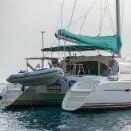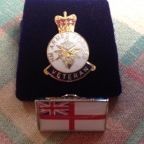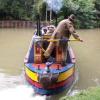Leaderboard
Popular Content
Showing content with the highest reputation on 16/01/18 in all areas
-
2 points
-
I think that you will find the BSS actually specifies the combined 'rating' . A BOAT OVER 36 FEET MUST HAVE 3 EXTINGUISHER WHERE THE TOTAL (ADD UP ALL THE INDIVIDUAL RATINGS) COMES TO A MINIMUM OF 21A/144B Your extinguishers comply with the specification but are undersized for your boat. 4x 5A = 20A. Minimum for your boat is 21A 4x 34B = 136B. Minimum for your boat is 144B Different manufacturers use different 'stuff' and get different ratings for the same weight, you need another 1 extinguisher to comply. You will find that 1kg extinguishers are pretty much a waste of time in a fire situation, and are unlikely to knock-back a fire to allow you to get to a door, you are unlikely to stop and pick up & carrty 2 or 3 extinguishers to enable you to get out. I would suggest you take them back and replace them with 3 2Kg (or more) extinguishers, that way you have a chance of getting out if you need to. I guess it comes down to "do you want a BSS pass, or for you to be able to escape a fire"2 points
-
Didn't know him as such, but saw him around quite a bit. Peaceful moorings, may the locks be in your favour.2 points
-
FFS its not a jetski. Also, when single handing, I frequently let the dog drive the boat whilst operating the locks. I think she would find it annoying and would wriggle out of a kill cord with her paws.2 points
-
2 points
-
2 points
-
You can get them from Edmunds Electrical for £299.59 plus vat plus £30 carriage - even if you collect them from the sales desk.1 point
-
This post cannot be displayed because it is in a forum which requires at least 10 posts to view.
-
Ok ok wouldnt mind being young but back in the sixties again please where we had a life.1 point
-
This post cannot be displayed because it is in a forum which requires at least 10 posts to view.
-
Biggest electrical wholesaler in the world every branch a profit center they might have paid 3-4 squids for it and sell it for as much as they can!!!!1 point
-
This post cannot be displayed because it is in a forum which requires at least 10 posts to view.
-
We use Nicholoson's to get the overview but I agree, the waterwayroutes maps have more detail and particularly where the piled moorings are on the Oxford (hooray) but they dont show the pubs (booo). A combination of both is the answer.1 point
-
There is a good reason why your insulation costs about £1 per m2 and celotex about £10 per m2. Something to think about when insulating your boat.1 point
-
Those top bearing units are usually well seized and rusted to the stock needing a hefty puller or wedges and sledge hammer or even oxy acetylene heat to remove it. Squirt penetrating oil around and leave it for a bit. The inner bearing track of the bearing unit should have visible on top around the sides 2 or 3 Allen head grub screws which secure it to the stock. If these are slackened right off, the stock with a bit of a tapping with a hammer on top with a wooden block MIGHT!! MiGHT! allow it to shift down a bit and settle down a little more into the cup on the skeg.1 point
-
1 point
-
This post cannot be displayed because it is in a forum which requires at least 10 posts to view.
-
I still like the old real paper Nicholsons, but then they've got all sorts of useful scribbles in the margins now, and all the nicest mooring places marked. Really annoys me when I get to one of them and found some inconsiderate sod has moored up in MY place.1 point
-
Again what you have quoted isn't connected, I think, to the point you are making - it was a simple light-hearted statement - the Nicholson's sectional maps do omit some very short stretches of some canals (fact). As to the original more serious point, you appear to have little understanding of how much I know about the history of the Grand Union canal and all its constituent companies. But I think you have completely misunderstood my previous post, which sought only to correct what the caption in Nicholsons says, (whether I agree with it or not). Well there you go, then, on this point we agree totally - my previous contributions on this subject (in this thread and elsewhere) say exactly the same.1 point
-
This post cannot be displayed because it is in a forum which requires at least 10 posts to view.
-
This post cannot be displayed because it is in a forum which requires at least 10 posts to view.
-
This post cannot be displayed because it is in a forum which requires at least 10 posts to view.
-
This post cannot be displayed because it is in a forum which requires at least 10 posts to view.
-
Perhaps local boaters could organise a roster. When he closes for lunch they stop for fuel; when he reopens they cast off without buying any.1 point
-
Thanks Dalslandia, but I think it might be prohibitively expensive to bring my injectors to Sweden! The air filter has just been cleaned, so I don't think it's a breathing problem, unless it's something more serious in the valve train. Could valve clearances being out cause similar symptoms, perhaps?1 point
-
1 point
-
These are the notes I made for myself. Method of Fixing Ventairs (for centrally sited) using only 4 roof fixing holes. The parts involved are: The SS UFO plate The top plate The bottom plate 12mm M5 Bolts (not screws) Yellow rawlplugs LSX Prepare the fixture as follows: Note some fit together well without glue. Glue 3 yellow plastic rawlplugs into the top plate so they project below & are flush(ish) above. FIT THE MOZZY NET! Glue the projections and the bottom plate post bases and glue the top plate to the bottom plate. ENSURE THE TWO PARTS ARE SAT TOGETHER CORRECTLY. THIS IS HARD! When set, trim off any exposed rawlplug. Fill the screwholes in the fixture with sealant This avoids the need to use screws into the roof for the fixture. It is not possible to screw or bolt the two plates together. Ensure the rubber sealing ring is seated correctly. Fitting: Locate approximate area. Locate neighbouring roof ribs Ensure not close to hand rail or other top sides features on roof Ensure no cables Drill small pilot hole from underneath Use this hole as bow/stern position guide only, drill new pilot midway between port & starboard (if required!) Drill starting hole must be the same size as the following hole saw (8mm???) Cut with 98mm hole saw with dab of trefolex (beware silicones). Faster works better, with cooling stops. No. The holesaw overloads the DeWalt drill. Use Starrett jigsaw blades, is easier. The Victron cannot cope - use the generator Paint the rim with Hammerite Fit the fixture in position Place the UFO in position: Ensure drain holes are in the lowest position Avoid screw holes in the lowest position Mark the UFO plate with a marker pen to indicate the bow-most point Ensure the fixture underneath is correctly seated Drill out one screw hole in the UFO and roof beneath to 4mm. This and the next hole should be in the long axis of the boat to minimise at this stage bending of the UFO plate. Tap out the hole to 5mm Drill out the UFO plate only hole to 5.5mm Refit & bolt this hole. Note - use 12mm M5 bolts not screws. Repeat for the second hole. The last two holes are harder because of the curvature of the roof but the process is the same. When all bolts fit easily then remove them one at a time and LSX the hole and the stem, rebolt & wipe clean. Addendum: Insulate any exposed steel inside the cabin around the projecting ventair as this will collect condensation at a great rate, but do it in such a way that the Ventair can be removed as necessary to clear the drainage channels. Difficult.1 point
-
This post cannot be displayed because it is in a forum which requires at least 10 posts to view.
-
This post cannot be displayed because it is in a forum which requires at least 10 posts to view.
-
1 point
-
Glad to hear you have got it sussed, I may have a few questions to ask when mine turns up.1 point
-
When we broke down last year we called CRT and explained the situation saying how long we thought repairs would take and were told to give them a call if this changed, when the allotted time came and were were still broken down we just called to extend the estimated repair time. In total we were broken down for 2 months. As long as you keep CRT informed as to the situation they are very reasonable to deal with.1 point
-
This post cannot be displayed because it is in a forum which requires at least 10 posts to view.
-
This post cannot be displayed because it is in a forum which requires at least 10 posts to view.
-
I realise I'm late to this party - but, for us, living on board is cheaper ... we have kept the house and rented it out so the tenant pays the mortgage (well, all but 35 quid a month of it)... it's fixed for 5 years and the tenant is long term so have guaranteed no rent rise during that period. Our mooring (not residential) costs 149 a month... licence circa 75 quid.... 2-3 bags of coal a week during winter = 96 quid a month... insurance was about 350 for the year .... diesel 80 litres a month give or take at 51.92 means about £408 a month before we eat... Obviously you have to factor in oil/filter changes and blacking etc. but it's still a cheap way of living and you focus on being responsible for your needs rather than face-book trivia etc.1 point
-
I regularly do Limehouse to Brentford in my narrowboat. The two main things that I attend to before going out: 1: Full diesel tank, 100% full. With a full tank the fuel will slosh around much less therefore there is less chance of picking up dirt from the bottom of the tank. 2: Full water tank. My water tank is in the bow. When I first started doing the tideway I used to go with an empty water tank thinking that it would be good to have less weight and more buoyancy in the bow. Over the years I have reversed that strategy. I found the boat was too lively, it kicked and bounced too much. So now I go with a full tank and the boat jumps about less. Once out there I do not allow anyone to go inside between Limehouse and Millbank. I have everybody outside, with lifejackets where I can see them. Obviously nobody on the front deck because they will at best get soaked or at worst risk being knocked overboard. Preparation of the front deck - I do nothing more than close the front doors tightly and make sure there is nothing in the well that could block the drain holes. And my final tip, you must always try to hit oncoming waves head on or as close to it as you can manage. And for waves coming at you from behind try to turn away from them and run down them like a surfer. This will involve a lot of steering but it is worth it. Taking a big wave sideways is very uncomfortable.1 point
-
Celotex is the trade name of the manufacturer. They make all sorts of panels, including the interior insulation panels that we are talking about for insulating the inside of a boat. Need to describe the exact type when comparing insulations. They also make exterior panels of various types from the cheapo ones for poor peoples homes through to the more expensive fire proof ones that will no doubt be used on the outside of the Buckingham Palace and Palace of Westminster upgrades. Jen Indeed. As long as it ignites in a similar way, or slower than wood, then that is good enough.1 point
-
Blame for that catastrophe is yet to surface ... I imagine though if the interior of a narrowboat got hot enough to ignite the stuff the occupants would have either abandoned ship or already have died!1 point
-
I do not argue in the least - an extract from the description of Celetex's premium product: RS5000, according to Celotex's website, has a Class 0 rating under UK building regulations, meaning it has the highest rating for preventing the spread of flames and prevents the spread of heat. However, its "health and safety datasheet" notes: "The products will burn if exposed to a fire of sufficient heat and intensity. Unless a material is completely inert I should think that the caveat above may apply. The multi-layer is class E as described, make from that what you will Euro class Example A1, A2 Stone wool, gypsum board B Painted gypsum board C Gypsum board with paper-based wallpaper D Wood E Fire-retardant EPS F Non-tested materials, EPS1 point
-
Multi-layer insulation 40mm is useful for small space and non-flat surfaces and can be fixed with a simple spray adhesive - various qualities available so here is an idea from Screwfix - still quite expensive though (others go up to around £150.00 roll!) https://www.screwfix.com/p/ybs-superquilt-multilayer-insulation-1-5-x-5m/80967 Celotex and similar rigid insulation are pretty much self extinguishing and will not react with PVC coated cables - something Polystyrene can do...1 point
-
Hi Col, Really sorry to here about your recent problems and hope that things are better soon. In the grand order of things the heater issue is minor. Please take this in the spirit is intended but I hate to see you "beating yourself with a big stick" over the heater. You have done all you can about the heater - would it be better to put it on "back burner" (excuse the pun) and wait to see what happens when it arrives. Vic1 point
-
1 point
-
0 points
-
Avoid Jablite panels. They are highly flammable (expanded polystyrene) and will give off toxic smoke in a fire. If you have a serious condensation problem, is there enough ventilation?0 points
This leaderboard is set to London/GMT+01:00























